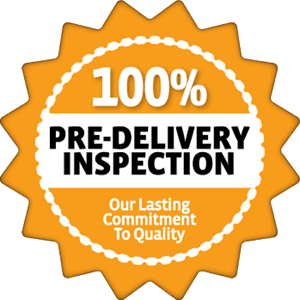How to Winterize an RV – Dutchmen RV Winterization Tips
October 31, 2016
RV Winterizing Protects More Than Just Surface Assets

For most of the country, it’s that time of year again. Time to put away the RV, whether that’s a travel trailer, toy hauler or fifth wheel during the harsh winter months. While it’s never an owner’s favorite task, it’s often one of the most important pieces to keeping your RV in prime condition. So here are two methods and some quick tips on how to winterize an RV:
WINTERIZING YOUR RV THE ‘DRY’ WAY
First, let’s begin with the “dry” version using the compressed air method with a bypass kit. The Compressed Air Method uses compressed air to blow out any remaining water in the drained system.
- What you’ll need:
- 1 to 2 gallons of RV non-toxic antifreeze (it should be pink in color)
- A wand to help clean out the tanks, if needed
- Water heater bypass kit, if it’s not already included in your Dutchmen RV
- Allows the plumbing system to bypass the hot water heater, which reduces the amount of antifreeze needed
- Available at most RV service centers
- Air compressor
- Requires a special adapter that allows compressed air to be delivered through the city water fill (available at most RV supply stores)
HOW TO WINTERIZE AN RV USING THE COMPRESSED AIR METHOD:
- Turn off all power sources, including propane tanks, and disconnect the RV from any outside power sources
- Use the air compressor to blow out the black tank flush system, if equipped
- Use a maximum of 30 psi to avoid damaging you Dutchmen RV
- Drain the fresh water tank and empty the waste water holding tanks
- If necessary, use a wand to assist the tank draining/cleaning process
- Drain the water heater at this point
- Never drain the water heater if it is hot or under pressure
- Turn the water heater bypass valve to the bypass position
- This is essential to make sure antifreeze doesn’t enter the freshwater tank
- You may have to remove an access panel first, depending on your RV
- Remove the water filter and discard, if installed; install diverter, if included
- Open all hot and cold faucets, including the shower head sprayer, toilet flushing device, water line drains and any outside showers
- Turn the water pump on for 30 seconds to clear out any water in the line
- Use the special adapter to connect the air hose to the city water fill connection
- Blow out the water lines until no water can be seen coming out of the fixtures and lines
- Again, don’t exceed 30 psi to avoid damaging any lines
- Close all drains
- Pour roughly 1 quart of RV antifreeze into each drain, toilet, tanks and P traps
Note: Do not drain the water heater first. That should be left for last to avoid wasting antifreeze by filling the water heater up.
WINTERIZING YOUR RV THE ‘WET’ WAY
Now, for the “wet” RV winterization with a bypass kit already installed. The RV Anti-Freeze Method uses approved, non-toxic and potable antifreeze in the system. No special tools are required, but it can take up to 10 gallons of RV antifreeze to complete.
- What you’ll need:
- 4 to 10 gallons of RV antifreeze (again non-toxic and pink in color)
- A wand to help clean out the tanks, if needed
- An air compressor or hand pump that’s available from most RV dealers
- A funnel for helping to fill tanks with RV antifreeze
- A bypass hose for the suction side of the water pump and necessary fittings
HOW TO WINTERIZE AN RV USING THE RV ANTI-FREEZE METHOD:
- Turn off all power sources, including propane tanks, and disconnect the RV from any outside power sources
- Use the air compressor to blow out the black tank flush system, if equipped
- Use a maximum of 30 psi to avoid damaging your RV
- Drain all tanks, fresh water and sewage tanks
- If necessary, use a wand to assist the tank draining/cleaning process
- Drain the water heater at this point
- Never drain the water heater if it is hot or under pressure
- Close the drains after water is drained
- Turn the water heater bypass valve to the bypass position
- You may have to remove an access panel first, depending on your Dutchmen RV
- Remove the water filter and discard, if installed; install diverter, if included
- Fill the fresh water tank with RV antifreeze so that it goes above the minimum water pump operating level
- Alternately, use a bypass hose on the suction side of the water pump to pull directly from the RV antifreeze container
- Turn on the pump switch and open the cold water side of all faucet fixtures
- Leave open until the antifreeze begins to come out
- Repeat for the hot water side and any outside showers
- Flush toilet until anti-freeze flows into the bowl, then pour 1 quart of antifreeze down the toilet to winterize the black tank, making sure to leave a small amount of antifreeze in the toilet to cover all of the seals
- Pour 1 quart of antifreeze down each shower, tub, sinks and P traps
Note: Again, do not drain the water heater first. That should be left for last to avoid wasting antifreeze by filling the water heater up.
ADDITIONAL TIPS TO HELP WHEN WINTERIZING YOUR RV
- Turn off the main circuit breaker
- Clean all appliances. This prevents corrosion and/or mold from forming
- Open the fridge door and make sure the freezer is thawed out and dry
- Shut off and store propane tanks upright in a protected location (not inside or in the RV)
- Check all vents, windows and doorways
- Re-caulk if necessary
- Clean and dry awnings or use a slip-on cover to prevent damage to the materials
- Cover any roof vents
- Prevent rodents and pest from infiltrating important components
- Cover any fittings and openings (rubber bands can hold these in place)
- Block the exhaust pipe with an approved material, such as steel wool
- Remove any batteries from electrical systems to prevent corrosion
- Disconnect main batteries and store in a warm and dry location (refer to the battery manufacturer’s instructions regarding care and maintenance)
- Use leveling jacks to take weight off the tires and to prevent flat spots from forming
- If you don’t have leveling jacks, make sure to rotate the wheels periodically
- Don’t park on uneven and non-solid surfaces
- Store your Dutchmen RV in a sheltered area or utilize a slipover cover that can help prevent debris and moisture from making its way into the RV
- Top all fuel tanks off to prevent condensation from forming inside
Whether you’re using the dry or wet method, make sure to consult your owner’s manual for additional questions and step-by-step procedures, such as proper winterization for icemakers, washing machines, dishwashers, etc. Or contact Dutchmen customer service toll free at 866-425-4369 with any questions you may have.
And if you’re running out of time or if you don’t feel like completing a full RV winterization yourself, you can take your RV to your Dutchmen dealer (typically October to April) to have them perform the full winterization for you.



